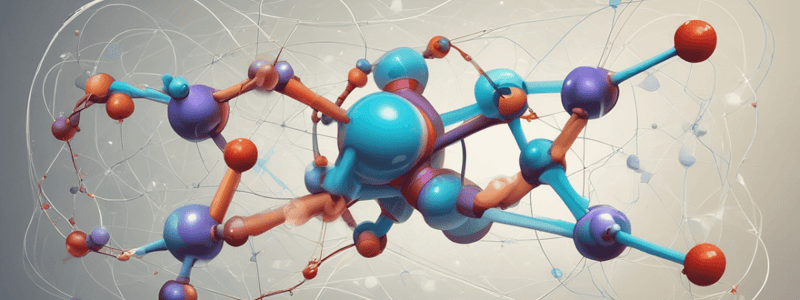Podcast
Questions and Answers
What is an ionic bond?
What is an ionic bond?
- The formation of sigma bonds between atoms
- The unequal sharing of electrons between two atoms
- The electrostatic force of attraction between oppositely charged ions (correct)
- The sharing of electrons between atoms
Which type of bond is characterized by the sideways overlap of p-orbitals?
Which type of bond is characterized by the sideways overlap of p-orbitals?
- Pi bond (correct)
- Sigma bond
- Ionic bond
- Polar covalent bond
What is the term for the number of bonds an atom of an element forms when it reacts?
What is the term for the number of bonds an atom of an element forms when it reacts?
- Ionization energy
- Valency (correct)
- Electronegativity
- Electron affinity
What is the electronic arrangement that atoms tend to reach when bonding occurs, according to the Octet Rule?
What is the electronic arrangement that atoms tend to reach when bonding occurs, according to the Octet Rule?
Which type of bond is characterized by the unequal sharing of electrons between two atoms?
Which type of bond is characterized by the unequal sharing of electrons between two atoms?
What is the term for electrons that are not involved in bonding?
What is the term for electrons that are not involved in bonding?
What is the primary reason why covalent compounds do not conduct electricity when molten or in solution?
What is the primary reason why covalent compounds do not conduct electricity when molten or in solution?
What is the result of the electrostatic force of attraction between oppositely charged ions?
What is the result of the electrostatic force of attraction between oppositely charged ions?
Why do ionic compounds typically have high melting and boiling points?
Why do ionic compounds typically have high melting and boiling points?
What is the difference between σ and π bonds?
What is the difference between σ and π bonds?
What is the result of the unequal sharing of electrons between two atoms in a covalent bond?
What is the result of the unequal sharing of electrons between two atoms in a covalent bond?
Why do covalent compounds typically have low melting and boiling points?
Why do covalent compounds typically have low melting and boiling points?
What is the term for the electrons that are shared in a covalent bond?
What is the term for the electrons that are shared in a covalent bond?
Flashcards are hidden until you start studying




